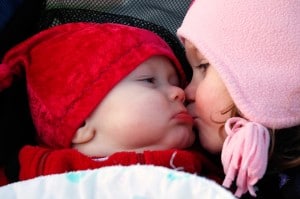
Using a non-invasive brain scanning technique called magnetoencepgalography (MEG), the researchers observed the brain activity of 57 infants aged seven, 11, or 12 months old. The infants listened to a series of syllables, like da and ta, in their Native language (English) and a foreign language (Spanish). The research team was particularly interested in brain activity in certain brain regions: the superior temporal gyrus, Broca’s area, the cerebellum, and cortical regions associated with planning motor movements for speech.
When infants hear speech sounds, brain activity occurs in the areas that coordinate the movements of spoken language. The seven-month-old infants exhibit similar brain activity when listening to both English and Spanish, but the 11- and 12-month old infants demonstrated increased motor activation in response to Spanish, their non-native language. This may suggest that it takes more effort for infant brains to predict the movements associated with non-native language speech.
The results indicate that activation in the movement-coordinating areas of the brain is a part of the transition infants make from recognizing speech to producing speech. The researchers posit that infant brains must first lay the groundwork of how to form words before they can begin to speak.
“Most babies babble by 7 months, but don’t utter their first words until after their first birthdays. Finding activation in motor areas of the brain when infants are simply listening is significant, because it means the baby brain is engaged in trying to talk back right from the start and suggests that 7-month-olds’ brains are already trying to figure out how to make the right movements that will produce words,” said lead study author Patricial Kuhl, co-director of the Institute for Learning and Brain Sciences.
This research is published in the Proceedings of the National Academy of Sciences.
Previous news in pediatric psychology:



 © 2025 Unyte Health US Inc.
© 2025 Unyte Health US Inc.